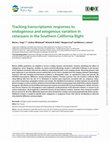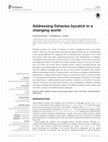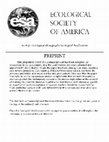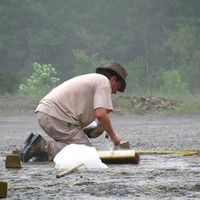Papers by Rebecca Lewison
Environmental Monitoring and Assessment, Jun 17, 2022

Biological Invasions, Jul 12, 2023
Forecasting habitat suitability and connectivity can be central to both controlling range expansi... more Forecasting habitat suitability and connectivity can be central to both controlling range expansion of invasive species and promoting native species conservation, especially under changing climate conditions. This study aimed to identify and prioritize areas in Spain to control the expansion of one of the most harmful invasive species in Europe, the American mink, while conserving its counterpart, the endangered European mink, under current and future conditions. We used ensemble habitat suitability and dynamic connectivity models to predict species ranges and movement routes considering likely climate change under three emission scenarios. Then, using habitat availability metrics, we prioritized areas for invasive mink control and native mink conservation and classified them into different management zones that reflected the overlap between species and threat from American to European minks. Results suggest that both species are likely to experience declines in habitat and connectivity under climate change scenarios with significantly larger declines by the end of the century for European minks (72 and 80% respectively) than for American minks (41 and 32%). Priority areas for management of both species varied over time and across emission scenarios, with a general shift in priority habitat towards the NorthEast of the study area. Our findings demonstrate how habitat suitability and dynamic connectivity approaches can guide long-term management strategies to control invasive species and conserve native species while accounting for likely landscape changes. The simultaneous study of both invasive and native species can support prioritized management action and inform management planning of the intensity, extent, and techniques of intervention depending on the overlap between species.

Research Square (Research Square), Jul 7, 2022
Forecasting habitat suitability and connectivity can be central to both controlling invasive spec... more Forecasting habitat suitability and connectivity can be central to both controlling invasive species expansion and promoting native species conservation, especially under changing climate conditions. This study aimed to identify and prioritize areas in Spain to control the expansion of one of the most harmful invasive species in Europe, while conserving its counterpart, the endangered European mink, under current and future conditions. We used dynamic ensemble habitat suitability and connectivity models to predict species ranges and movement routes considering likely climate change under three emission scenarios. Then, using habitat availability metrics, we prioritized areas for invasive mink control and native mink conservation and classi ed them into different management zones that re ected the overlap between species and threat from American to European minks. Results suggest that both species are likely to experience declines in habitat and connectivity under climate change scenarios with signi cantly larger declines by the end of the century for European minks (72 and 80% respectively) than for American minks (41 and 32%). Priority areas for management of both species varied over time and across emission scenarios, with a general shift in priority habitat towards the NorthEast of the study area. Our ndings demonstrate how dynamic habitat suitability and connectivity approaches can guide long-term management strategies to control invasive species and conserve native species while accounting for likely landscape changes. The simultaneous study of both invasive and native species can support prioritized management action and inform management planning of the intensity, extent, and techniques of intervention depending on the overlap between species.

Biological Conservation, May 1, 2021
Abstract Roads negatively affect wildlife populations directly as a source of mortality and indir... more Abstract Roads negatively affect wildlife populations directly as a source of mortality and indirectly through habitat fragmentation, restricted movement, and altered habitat use. Wildlife crossing structures and roadside fencing are two common road mitigation strategies implemented to reduce wildlife road mortalities and maintain population connectivity. Metrics quantifying use of crossing structures by wildlife are often used to determine their effectiveness, but interpreting these metrics can be challenging when local population processes and individual variation in use are not considered. We used over six years of remote camera data, including two years of post-construction data, from a road improvement project in south Texas to evaluate mitigation efforts in the context of long-term felid abundance. Variation in seasonal felid abundance was tied to precipitation in the preceding 12 months, highlighting the importance of accounting for baseline wildlife abundance when measuring structure efficacy. Crossing structure use by felids was positively correlated with abundance estimates, though frequency and consistency of use varied among individuals. Probability of use was related to roadside fencing, canopy cover, time since crossing construction, and presence of water in the structure. Our results suggest that conventional indices of crossing structure effectiveness, such as crossing rates, are more informative when ongoing population processes are considered. By interpreting structure use in the context of long-term abundance trends and individual variation, managers can compare use across sites to better determine factors that influence crossing structure effectiveness and take steps to site, construct, and maintain structures that enable safe wildlife road crossing and promote connectivity.

Anthropocene, Sep 1, 2020
Payments for ecosystem services (PES) programs have been implemented worldwide to balance human n... more Payments for ecosystem services (PES) programs have been implemented worldwide to balance human needs and ecosystem conservation. However, the effects of PES programs on economic activities and the associated effects on wildlife remain unclear. China's Grain-to-Green program (GTGP) that aims to convert cropland to forest or grassland represents one of the largest PES programs in the world. We combine household surveys with wildlife camera data to ask whether GTGP is associated with direct or indirect effects on economic activities, wildlife occupancy and wildlife species richness. We also consider how resource use and extraction, wildlife occupancy, and species richness differ between GTGP and natural forest sites. We found that farming and the amount of fuelwood extracted from forests have declined, while the collection of other forest resources remained largely unchanged. While residents engaged less in cattle grazing after GTGP implementation, goat grazing and pig forage collection remained unchanged. Paired camera trap and household survey data analyses suggest that presence of humans and dogs was positively related to resource collection, and negatively related to wildlife occupancy, which likely contributed to the lower wildlife species richness detected at GTGP forest relative to natural forest. The results suggest that while PES programs, like GTGP, may reduce some human impacts on forest ecosystems (i.e. reduced firewood collection and cattle grazing) and provide habitat for wildlife through afforestation, the persistence of other types of resource use may limit the positive benefits of PES to wildlife diversity. Our results suggest there may be opportunities for PES programs to extend the multi-benefit approach of balancing human needs and ecosystem services to increase potential benefits to wildlife and biodiversity.

Gulf of Mexico Science, 2016
We developed a Kemp's ridley (Lepidochelys kempii) stock assessment model to evaluate the relativ... more We developed a Kemp's ridley (Lepidochelys kempii) stock assessment model to evaluate the relative contributions of conservation efforts and other factors toward this critically endangered species' recovery. The Kemp's ridley demographic model developed by the Turtle Expert Working Group (TEWG) in 1998 and 2000 and updated for the binational recovery plan in 2011 was modified for use as our base model. The TEWG model uses indices of the annual reproductive population (number of nests) and hatchling recruitment to predict future annual numbers of nests on the basis of a series of assumptions regarding age and maturity, remigration interval, sex ratios, nests per female, juvenile mortality, and a putative ''turtle excluder device effect'' multiplier starting in 1990. This multiplier was necessary to fit the number of nests observed in 1990 and later. We added the effects of shrimping effort directly, modified by habitat weightings, as a proxy for all sources of anthropogenic mortality. Additional data included in our model were incremental growth of Kemp's ridleys marked and recaptured in the Gulf of Mexico, and the length frequency of stranded Kemp's ridleys. We also added a 2010 mortality factor that was necessary to fit the number of nests for 2010 and later (2011 and 2012). Last, we used an empirical basis for estimating natural mortality, on the basis of a Lorenzen mortality curve and growth estimates. Although our model generated reasonable estimates of annual total turtle deaths attributable to shrimp trawling, as well as additional deaths due to undetermined anthropogenic causes in 2010, we were unable to provide a clear explanation for the observed increase in the number of stranded Kemp's ridleys in recent years, and subsequent disruption of the species' exponential growth since the 2009 nesting season. Our consensus is that expanded data collection at the nesting beaches is needed and of high priority, and that 2015 be targeted for the next stock assessment to evaluate the 2010 event using more recent nesting and in-water data.

Conservation Physiology, 2019
Marine wildlife populations are adapted to survive in highly dynamic environments. However, ident... more Marine wildlife populations are adapted to survive in highly dynamic environments. However, identifying the effects of endogenous versus exogenous variables on marine mammal physiology remains a substantial challenge in part because of the logistical constraints that limit the collection of physiological data in free-ranging animals. Measuring genome-wide gene expression is one minimally invasive method that can be used to elucidate how free-ranging cetaceans' physiological responses shift with changing environmental conditions or demographic states, i.e. reproductive status and maturity. We identified transcriptomic differences among bottlenose dolphins (Tursiops truncatus) from the Southern California Bight using RNAseq data from the skin of 75 individuals to examine gene expression associated with sex, pregnancy status, sea surface temperature, geographic location and ecotype. We identified transcriptomic variation between two genetically distinct ecotypes as well as variation related to environmental conditions among groups that exhibit little evidence of genetic divergence. Specifically, we found differential expression of genes associated with structural development, cellular starvation and immune response. Sex and pregnancy status explained a small proportion of the observed variation, in contrast to sea surface temperature, which explained a substantial amount of transcriptomic variation. However, these measured variables did not account for all of the differential expression observed between ecotypes and among geographically distinct groups. Additional research is needed to identify other endogenous or exogenous factors that may be contributing to observed transcriptomic differences among ecotypes.
American Geophysical Union eBooks, Feb 1, 2016

Landscape Ecology, Jun 1, 2020
Context For depleted wildlife populations, understanding and effectively mitigating the direct an... more Context For depleted wildlife populations, understanding and effectively mitigating the direct and indirect impacts of roads can be a key component of recovery efforts. The ocelot is a federally endangered wild felid at risk of local extinction in south Texas, where vehicle collisions are their largest known source of mortality. Objectives To support road mortality mitigation, we evaluated mortality risk across the south Texas road network. We also assessed whether a sympatric carnivore, the bobcat, could serve as a surrogate to inform mortality risk. Methods We used several presence-only species distribution models to evaluate a suite of candidate landscape and road attributes and identify those associated with elevated road mortality risk using a 35-year wild felid road mortality dataset. Consensus predictions among models identified high-risk road segments for ocelots and bobcats. We compared predictions between species to determine overlap of high-risk areas. Results Areas where core ocelot habitat intersected roadways represented the greatest mortality risk, reflecting ocelot reliance on intact habitat and avoidance of degraded and fragmented landscapes. Bobcat road mortality risk had similar relationships to landscape features, with nearly all areas classified as highrisk for ocelots also identified as high-risk for bobcats. Conclusions Ocelots are vulnerable to road mortality in areas where roads intersect their intact scrub habitat. Bobcats, with appropriate data filters in place, are an acceptable surrogate for informing ocelot road mortality, particularly when ocelot mortality data are limited and for time-sensitive conservation decisionmaking. For ocelots and other fragmentation-intolerant carnivore species, wildlife underpasses and fencing in focused areas where roads and intact habitat intersect may be feasible options to reduce road mortality. Keywords Wildlife-vehicle collision Á Road mitigation Á Ocelot (leopardus pardalis) Á Bobcat (lynx rufus) Á Species distribution model Á Habitat fragmentation Electronic supplementary material The online version of this article (

BioScience, Sep 1, 2017
Citizen-science (CS) programs provide a cost-effective way to collect monitoring data over large ... more Citizen-science (CS) programs provide a cost-effective way to collect monitoring data over large temporal and spatial scales. Despite the recent proliferation of these programs, some in the conservation and management community remain skeptical about the quality of information generated, in part because of the lack of a rigorous framework for program evaluation. Drawing from the CS literature, we developed a structured rubric to guide the evaluation of CS programs. We test the utility of the rubric by conducting an internal and external review of a case-study CS program. The case study demonstrates the importance of the evaluation process and the effectiveness of the rubric to identify program elements that needed improvement. Our results support the assertion that program evaluation using a structured rubric can help CS programs meet their objectives, promote CS data usage in conservation and management, and maximize CS return on investment.

Frontiers in Marine Science, Oct 27, 2015
Fisheries bycatch is a threat to species of marine megafauna across the world's oceans. Work over... more Fisheries bycatch is a threat to species of marine megafauna across the world's oceans. Work over the past several decades has greatly advanced our understanding of the species affected, the magnitude and the spatial extent of bycatch. In the same time period, there have been substantial advances in the development of mitigation strategies and best practices to reduce bycatch. In this paper, we take stock of bycatch knowledge and science to address the critical question "Where do we go from here?" First, we review the current state of global bycatch science, including bycatch rate estimation and biological effects of bycatch, and bycatch mitigation practices and gear. We then identify knowledge gaps as well as socio-cultural constraints that hamper effective knowledge transfer or implementation, and discuss emerging transdisciplinary approaches to address these issues. Finally, we discuss the need to consider bycatch in a changing ocean and socio-cultural context where species, ecosystems, and people are responding to multiple stressors and dynamic conditions. As the field of bycatch research moves into the twenty-first century, a new perspective is needed to develop responsive strategies that effectively address the shifting ecological, social, cultural, and economic contexts of the global bycatch seascape.

Journal of Artificial Societies and Social Simulation, 2020
The theory and practice associated with payments for ecosystem services (PES) feature a variety o... more The theory and practice associated with payments for ecosystem services (PES) feature a variety of piecemeal studies related to impacts of socioeconomic, demographic, and environmental variables, lacking e orts in understanding their mutual relationships in a spatially and temporally explicit manner. In addition, PES literature is short of ecological metrics that document the consequences of PES other than land use and land cover and its change. Building on detailed survey data from Fanjingshan National Nature Reserve (FNNR), China, we developed and tested an agent-based model to study the complex interactions among human livelihoods (migration and resource extraction in particular), PES, and the Guizhou golden monkey habitat occupancy over years. We then performed simulation-based experiments testing social and ecological impacts of PES payments as well as human population pressures. The results show that with a steady increase in outmigration, the number of land parcels enrolled in one of China's major PES programs tends to increase, reach a peak, and then slowly decline, showing a convex trend that converges to a stable number of enrolled parcels regardless of payment levels. Simulated monkey occupancy responds to changes in PES payment levels substantially in edge areas of FNNR. Our model is not only useful for FNNR, but also applicable as a platform to study and further understand human and ecological roles of PES in many other complex human-environment systems, shedding light into key elements, interactions, or relationships in the systems that PES researchers and practitioners should bear in mind. Our research contributes to establishing a scientific basis of PES science that incorporates features in complex systems, o ering more realistic, spatially and temporally explicit insights related to PES policy or related interventions.

Endangered Species Research, Jun 4, 2020
Marine mammal bycatch poses a particular challenge in developing countries, where data to documen... more Marine mammal bycatch poses a particular challenge in developing countries, where data to document bycatch and its effects are often lacking. Using the Bycatch Risk Assessment (ByRA) toolkit, based on InVEST open-source models, we chose 4 field sites in Southeast Asia with varying amounts of data on marine mammals and fishing occurrence: Trat province in the eastern Gulf of Thailand, the Sibu-Tinggi Islands and Kuching Bay, Malaysia, and Kien Giang Biosphere Reserve in southwestern Vietnam. These field sites have similar species of coastal marine mammals, small-scale and commercial fisheries, and support for research from universities and/or management. In Thailand and Kuching, results showed changing patterns of fishing and Irrawaddy dolphin Orcaella brevirostris habitat use across seasons, showing how bycatch risk could change throughout the year. Risk maps for dugongs Dugong dugon in peninsular Malaysia highlighted patterns of bycatch risk concentrated around a mainland fishing pier, and revealed high risk in a northern subregion. In Vietnam, first maps of bycatch risk for the Irrawaddy dolphin showed the highest risk driven by intensive use of gillnets and trawling gear. ByRA pinpointed areas of spatial and seasonal bycatch exposure, and estimated the consequence of bycatch on local species, providing managers with critical information on where to focus bycatch mitigation and meet new global standards for US Marine Mammal Protection Act and other international regulation (e.g. Official Journal of the European Union 2019; Regulation 2019/1241) compliance. The toolbox, a transferable open-source tool, can be used to guide fisheries management, marine mammal conservation, spatial planning, and further research.

Applied Geography, Oct 1, 2019
China is a biodiversity hotspot that is part of a larger, multi-use landscape where tourism, farm... more China is a biodiversity hotspot that is part of a larger, multi-use landscape where tourism, farming, grazing, and other land uses occur. Payment for ecosystem services (PES) programs that encourage afforestation on farmlands may be important drivers of land-cover and land-use change in the region that surrounds FNNR. Our objective is to monitor and examine vegetation and land-use changes, including PES-related afforestation, between 1989 and 2017. We utilize several image processing techniques, such as illumination normalization approaches to suppress terrain effects, and multi-seasonal image compositing to minimize persistent cloud cover. Ancillary data were also incorporated to generate reliable vegetation and land-use change information. A random forest machine learning image classification routine is implemented through the cloud-based Google Earth Engine platform and refined using optimal classifier parameter tuning. Land-use transitions are identified and mapped with the implementation of stable training sites, discrete image classification, and logical land-use transition rules. Accuracy assessment results indicate our change detection workflow provides a reliable methodology to remotely monitor long-term forest cover and land-use changes in this mountainous, forested, and cloud prevalent region. We quantify the area of new built development and afforestation land and found that most of the land transitions took place in reserve buffer and its adjacent environs. For example, less than 2 km 2 of new built was identified within the reserve boundary compared to 25 km 2 for the entire study area between 1995 and 2016. We also shed light on the strengths and weaknesses of using Google Earth Engine for land-cover and land-use change studies. This efficient and open-access technique is important not only for assessing environmental changes and PES efficacy, but also for evaluating other conservation policies elsewhere.

Animal Biotelemetry, Dec 1, 2016
Background: Ocean water temperature is changing as a result of anthropogenic influences on the ma... more Background: Ocean water temperature is changing as a result of anthropogenic influences on the marine environment. Highly mobile marine ectotherms, such as sea turtles, may be particularly susceptible to these changes. However, our current understanding of location-specific thermal tolerances, especially at coastal foraging or over-wintering areas, is limited. Human-induced changes, such as thermal effluent from power plants, appear to have a suite of influences on species that reside in affected areas. Here, we describe a study of green turtle habitat use related to changing water temperature at a coastal foraging site that has recently experienced a power plant closure, leading to a transition to cooler ambient water temperature. We used a combination of active and passive acoustic telemetry to monitor green turtle distribution in relation to water temperature in this dynamic thermal environment. Results: Both before and after closure of the power plant, turtles were distributed in significantly warmer waters than surrounding environments during winter months (December-February). Turtles in winter were rarely detected in water temperatures lower than 14.5 °C. Body size was negatively correlated with water temperature after closure of the power plant, with larger turtles found in cooler waters, while smaller turtles remained within warmer areas. There was not a significant relationship between body size and water temperature before closure of the power plant as water temperature was more constant during operation. Conclusions: Green turtles in San Diego Bay experienced a shift in water temperature following the loss of thermal effluent from a power plant. The effects of this shift were particularly evident during winter months, when ambient water temperatures were coolest. Water temperatures in the southern region of San Diego Bay were significantly warmer during winter before the closure of the power plant, and turtles were detected in significantly warmer water. Turtles in San Diego Bay may associate with or seek out thermal refugia, when possible, to avoid low water temperatures. The cold water temperature inactivity threshold for East Pacific green turtles may be lower than previously thought. There was a significant negative relationship between turtle size and water temperature after power plant closure. East Pacific green turtles exhibit clear responses in habitat use to changes in water temperature at a foraging site near the edge of their geographic range.

Ecological Applications, 2016
Intrinsic population growth rate (r max ) is an important parameter for many ecological applicati... more Intrinsic population growth rate (r max ) is an important parameter for many ecological applications, such as population risk assessment and harvest management. However, r max can be a difficult parameter to estimate, particularly for long-lived species, for which appropriate life table data or abundance time-series are typically not obtainable. We describe a method for improving estimates of r max for long-lived species by integrating life-history theory (allometric models) and population-specific demographic data (life table models). Broad allometric relationships, such as those between life history traits and body size, have long been recognized by ecologists. These relationships are useful for deriving theoretical expectations for r max , but r max for real populations may vary from simple allometric estimators for 'archetypical' species of a given taxa or body mass. Meanwhile, life table approaches can provide population-specific estimates of r max from empirical data but these may have poor precision from imprecise and missing vital rate parameter estimates. Our method borrows strength from both approaches to provide estimates that are consistent with both life-history theory and population-specific empirical data, and are likely to be more robust than estimates provided by either method alone. Our method uses an allometric constant: the product of r max and the associated generation time for a stable-age population growing at this rate. We conducted a meta-analysis to estimate the mean and variance of this allometric constant across well-studied populations from three vertebrate taxa (birds, mammals, and elasmobranchs) and found the mean was approximately 1 for each taxon. We used these as informative Bayesian priors that determine how much to 'shrink' imprecise vital rate estimates for a data-limited population toward the allometric expectation. The approach ultimately provides estimates of r max (and other vital rates) that 3 reflect a balance of information from the individual studied population, theoretical expectation, and meta-analysis of other populations. We applied the method specifically to an archetypical petrel (representing the genus Procellaria) and to white sharks (Carcharodon carcharias) in the context of estimating sustainable fishery bycatch limits.

Marine Policy
Despite progress in understanding and predicting climate change impacts and possible responses fo... more Despite progress in understanding and predicting climate change impacts and possible responses for US marine fisheries, use of climate-related information in federal fishery management decisions remains limited. One barrier to progress in linking climate knowledge to management action is that individual management bodies’ efforts tend to be isolated, with few opportunities to coordinate or communicate about successes and shared challenges. To promote cross-regional learning, we distill eight best practices from emerging climate-focused efforts, drawn from a collaborative workshop, literature, and authors’ experiences. We conceptualize these best practices as interrelated—and incomplete—pieces of a knowledge-to-action “puzzle” that could be adopted based on regional context. One best practice, mapping out management processes and structure to identify “on-ramps” for climate information (3.1), represents a foundational centerpiece that enables other best practices. Three practices apply primarily to internal management processes: frame climate initiatives within existing management mandates and processes (3.2); strategically incorporate qualitative information to deal with uncertainty (3.3); and pilot initiatives with healthy or lower-risk stocks (3.4). Another set pertains to efforts that include broader stakeholders: engage stakeholders early and often (3.5), emphasize local priorities (3.6), employ structured processes to keep initiatives on track (3.7), and leverage collaborative research to build trust and overcome capacity constraints (3.8). We highlight emerging initiatives that demonstrate how these practices were implemented, discuss continued challenges, and identify opportunities where these practices could be expanded in support of climate-ready fisheries.

The Northwest Atlantic Ocean and Gulf of Mexico are among the fastest warming marine ecosystems, ... more The Northwest Atlantic Ocean and Gulf of Mexico are among the fastest warming marine ecosystems, a trend that is expected to continue through this century with concomitant changes to large-scale currents and far-reaching implications for ocean dynamics and marine ecosystems. Here we examine the distribution of 12 highly migratory top predator species using predictive models and project expected habitat changes to 2100 using three downscaled climate model outputs. Our models predict widespread losses of suitable habitat for most species, concurrent with substantial northward displacement of core habitats that exceed 500 km. These changes include up to a >70% loss of suitable habitat by area for some commercially- and ecologically-important species. We also identify predicted hotspots of multi-species habitat loss focused offshore of the U.S. Southeast and Mid-Atlantic coasts. For several species, the predicted changes are already underway, which are likely to have significant impa...











Uploads
Papers by Rebecca Lewison